
1
ISSN: 2321 9653; IC Value: 45.98; SJ Impact Factor: 7.538

Volume 10 Issue XI Nov 2022 Available at www.ijraset.com


1
ISSN: 2321 9653; IC Value: 45.98; SJ Impact Factor: 7.538

Volume 10 Issue XI Nov 2022 Available at www.ijraset.com
2
 Asst,Professor,
Asst,Professor,
2PG Students, Department Of Mechanical Engineering, Nandha Engineering College, Autonomous, Erode, Tamil Nadu, India
Abstract: The fuel cell is an electrochemical cell is use to fuel to fuel source for automobile application. It is process to chemical energy converts of water vapor. The normally used to fuel source is coal energy, electrical and solar energy. Renewable resources fuel source of the vehicles power. From the literature survey it has been found that “polymer electrolyte membrane fuel cell” (or) “proton exchange membrane fuel cell”. Fuel cells are very useful as renewable power sources in remote location. It is small weight are most suited of transportation application.. The fuel cell is direct current (dc). The proton exchange membrane fuel cell output power is (50 250 kw) . it is low temperature compare to other fuel cell. The PEMFCs so efficiencies vary but most are between 40 % and 60 % energy efficient.
Keywords: gear bicycle, polymer electrolyte membrane fuel cell, coal energy, electrical energy, solar energy. I. INTRODUCTION
Low carbon steel (AISI 1018) has excellent weldability & produces a uniform and harder case and it is considered the best steel for carburized parts. Specific manufacturing controls are used for surface preparation, chemical composition, rolling and heating processes. Low carbon steel offers a good balance of toughness, strength and ductility. It is used to improve drilling, machining, threading and punching process. M. Badruddin et.al., [21] said that this paper is investigation of mechanical properties of cold drawn AISI 1018 at high temperature steady state conditions. The proposed models for prediction of the high temperature mechanical properties of CDS AISI 1018 could be used to evaluate the response of CDS AISI 1018 structures in a fire if the thermal creep effect is not significant. M. Badruddin et.al.,[22] said that low cycle fatigue properties of aluminizing Coating on cold Drawn AISI 1018 steel. This testing is two typing in mechanical and the low cycle fatigue (LCF) properties of cold drawn AISI 1018 steel (CDS 1018) with and without hot dip aluminizing (HDA) coating had been experimentally investigated at room temperature. The tensile properties and the LCF properties were determined from tensile test results and cyclic strain fatigue test results, respectively. Mohammed Z. Hasan et.al.,[24] said that Liquid carburizing is considered as one of surface heat treatment techniques of steel, where it is possible to produce surface layers with high hardness and good corrosion wear resistance carburizing process. Increasing the period leads to an increase in the effective thickness or depth of the carbonized layer formed on the surface Polymer exchange membrane (PEM) Fuel cells, is being developed mainly for transport application, As well as for stationary fuel cell application and portable fuel cell application. The materials lower temperature pressure ranges (50 to 100oC) and a special proton conducting PEMFCs generate electricity and operate on the opposite principle to (PEM)electrolysis, which consumes electricity PEMFCs have high power density, low weight and volumes as compared to other fuel cells. Low temperature operation allows them to start quickly and also results in less wear and tear of system components. Noor U1 Hassan.et.al [2] study the polymer electrolyte membrane fuel cell in bipolar plate is one of the most significant contributes substantially Graphite polymer composites to the low cost structure and the light weight of the stacks. It is main aim of the low cost and light weight bipolar plates using novel design, fabrication method and high performance. Azadeh Kheirandish.et.al [3] Said Fuel cells on pollution caused by burning fossil fuels, proton exchange membrane fuel cell is advances for the future of the transportation industry. This aim of dynamic model for (pem) fuel cell is using an electric bicycle. It is the good results in linear regression model. Azadeh Kheirandish.et.al [4] this said that experimental process in Zero emission fuel cell driven systems are advances in the future of the transportation industry that have the potential to replace internal combustion engines, it is also save up to 28% of energy in electric vehicle. Azadeh Kheirandish.et.al [5] Said that Modelling Proton Exchange Membrane Fuel Cell is the fundamental step in designing efficient systems for achieving higher performance.
ISSN: 2321 9653; IC Value: 45.98; SJ Impact Factor: 7.538 Volume 10 Issue XI Nov 2022 Available at www.ijraset.com

Fig.1.2. Proton exchange member fuel cell

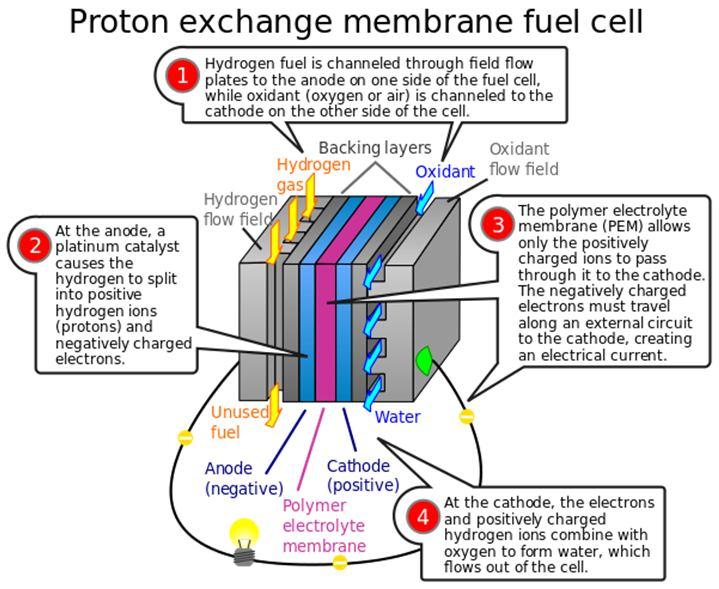
Dimitrios Apostolou [6] Said that estimation in bike range under different routes and rides the rider opinions and a low financial evaluation of hydrogen fuel cost compared to other urban vehicle alternatives. This is low pressure hydrogen storage it is used light duty vehicles. Yean Der Kuana.et.al [7] Said that using reinforced composite laminate graphite bipolar plate is designed to have high electric conductivity, low corrosion and good mechanical strength characteristics. It is main aim thermoset type phenolic resin process as matrix with a plain type graphite fiber cloth adopted as the composite laminate reinforcement. The two common materials adopted for bipolar plates are carbon and metal. The developed bipolar plates is good stability are assembled into a single cell and tested . Xiong Shusheng.et.al [8] Said that on board hydrogen using fuel cell vehicles power source to drive the motor & lithium battery is used as the auxiliary power source to accelerate and recycle energy in order to meet the special requirements, like energyrecovery, power and dynamic characteristics vehicles. It is compared to fuel cell hybrid drive pure fuel cell drive. Meiyappan siva pandian.et.al [9] Said that efficiency and economics is using polymer electrolyte membrane fuel cell best performance & advantages, like simplicity, lifetime effectiveness, quick start up, low operating temperature and easy maintenance. The fuel cells as an parameters alternative power source have its electrical efficiency and also power output directly related to its economics. Wei Lung Yua.et.al [10] Convey that it’s analysis in proton exchange membrane fuel cell various combinations of these parameters there are six primary parameters. It’s two method fractional factorial design & Taguchi method. It is possible to improve the fuel cell performance. Kui Jiao.et.al [13] polymer electrolyte membrane fuel cell (PEMFC) technology, there has been increasing demand for clean and sustainable global energy applications. The many device level and infrastructure challenges that need to be overcome before wide commercialization can be realized, one of the most critical ones is increasing the PEMFC power density, and ambitious goals have been proposed globally. M. Muthukumar.et.al [19] Studied the working principle and the performance curves of fuel cells used for FCEV are discussed. The various components and accessories used in fuel cell systems and electric systems are studied. The efficiency of a fuel cell is analysed in different load profiles. As it is unable run a vehicle in one single fuel cell, we tend to stack the fuel cell in series or parallel to get the maximum power productivity to operate the vehicle.
Fig. 2.1. 2D bicycle frame

Fig. 2.2. 3D bicycle frame


ISSN: 2321 9653; IC Value: 45.98; SJ Impact Factor: 7.538 Volume 10 Issue XI Nov 2022 Available at www.ijraset.com

Bicycle frame parts measurements 1. Seat tube length 420.00 mm 2. Top tube length 639.99 mm
The gear bicycle is environmentally friendly, safe and are a form of exercise with many other advantages, the bicycle industry has promoting them as green products. the major producer of bicycles and their components and is a centre for the development of manufacturing process technology and materials science. The appearance of a bicycle is no longer limited to the traditional style research and development have led to ergonomic designs with low riding drag, a lightweight frame, greater strength, and improved handling to meet customized needs. There are several challenges faced during the integration of customer/user requirements into the design process. In many instances, customers do not have knowledge on how to design the product, and customer specified configurations need to be feasible and optimized for performance. The gear bicycle frame is a standard component of a bicycle, and every bicycle factory has a different design. Other important components are the tires, wheels, and pedals. The geometry of the frame governs the properties and performance of the bicycle. The lengths and angles of the frame affect a rider’s riding comfort and behavior. The gear bicycle fuel cell using fuel cell technology, which uses pollution free hydrogen gas to generate an electric current, could ignite gear bicycle fuel cell. It is gear bicycle by using fuel cell lifelong fuel source. In this software in first analysis in low corban steel metals pipeline part.
The materials preferred by bicycle frame is best quality, capability & costly low for this low carbon steel. The low carbon steel material is used to best mechanical properties & good hardness , high strength its also good bicycle structure frame materials the is AISI 1020 & AISI 1018 as well as same materials properties. This is AISI 1018 is used to good weld ability, relatively, soft and strengthens & good manufacturability.
The AISI 1018 material is important is high impact for frame working materials. A. Guevara Morales et.al., [23] said Wear resistance of diffusion annealed borided AISI 1018 steel. the FeB layer are apply new results on the wear behaviour of AISI 1018 steel exposed to powder pack boriding process (PPBP) and to the diffusion annealing process (DAP), which were evaluated through ball on flat linear reciprocating wear tests under different sliding distances are presented. This phenomenon generated a combined effect of adhesive and abrasive wear which resulted in the formation of agglomerations that were transferred to the surface of the wear track.

The model of solid works premium 2021 SP05
This software is structural integrity of the bicycle frame of the design is verified by comparing the analysis result with the standard values of the materials.
This software is analysis in AISI 1018 PIPE structural material. Anh Dinh le & Biao Zhou[1] Study a 3D setup of polymer electrolyte membrane fuel cell was constructed, it is us to FLUENT it developing own governing and relative equations. It is find out the PEMFCs implemented and employed to simulate the fluid flow, heat transfer, species transport, electrochemical reaction, and current density distribution, especially focusing on liquid water effects on performance & user defined function, gas diffusion layers, catalyst layers and current collectors.
ISSN: 2321 9653; IC Value: 45.98; SJ Impact Factor: 7.538 Volume 10 Issue XI Nov 2022 Available at www.ijraset.com

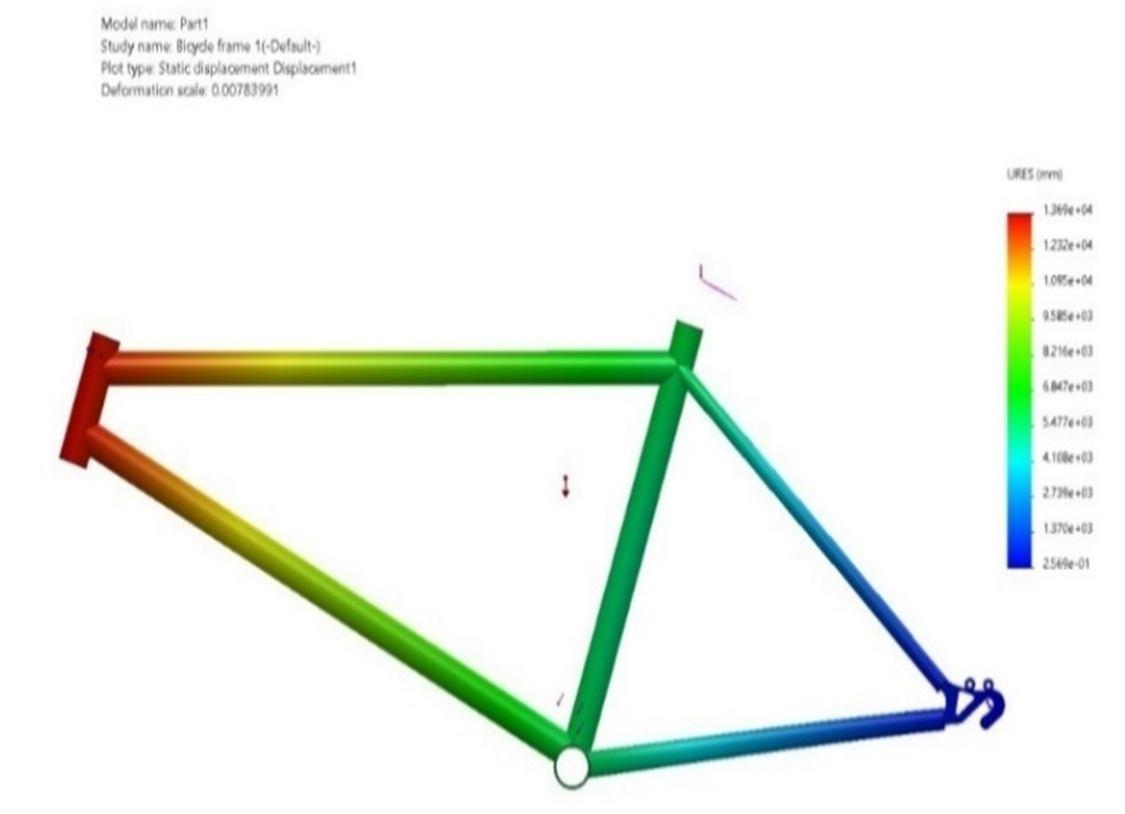
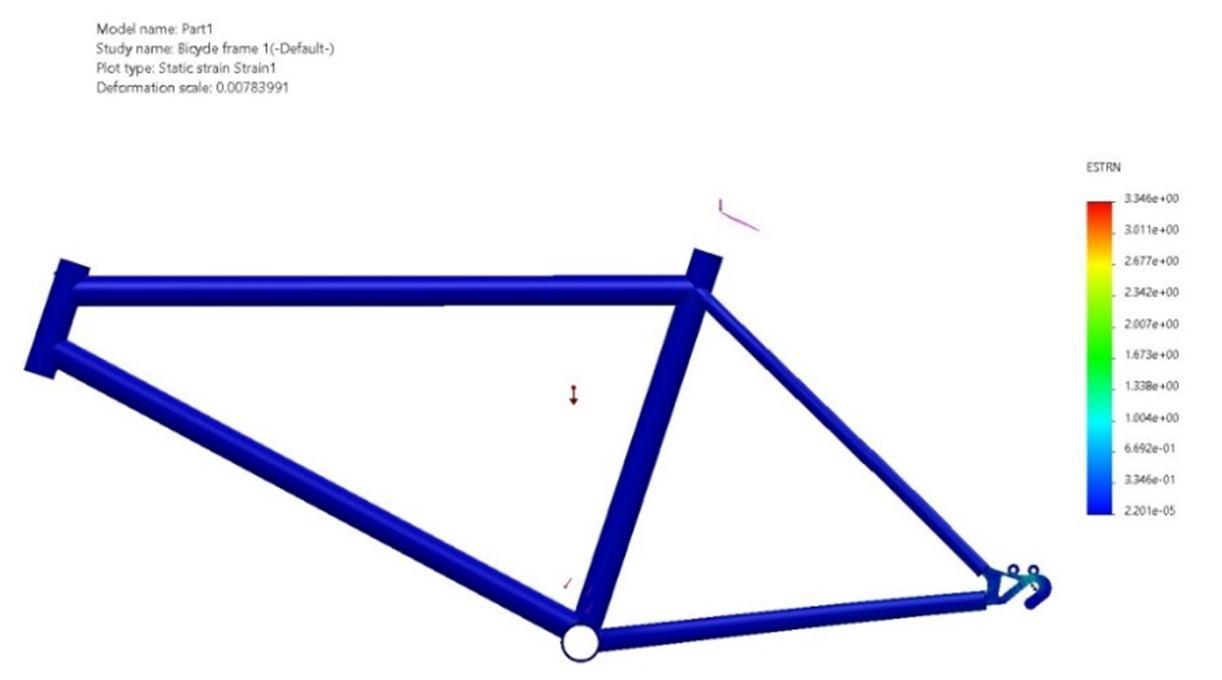

Table. 3.1. Acting Load 10 Kgf
FORCE KgF ANAYLSIS PIPE (AISI 1018) STRESS 10 DISPLACEMENT 10 STRAIN 10

ISSN: 2321 9653; IC Value: 45.98; SJ Impact Factor: 7.538 Volume 10 Issue XI Nov 2022 Available at www.ijraset.com

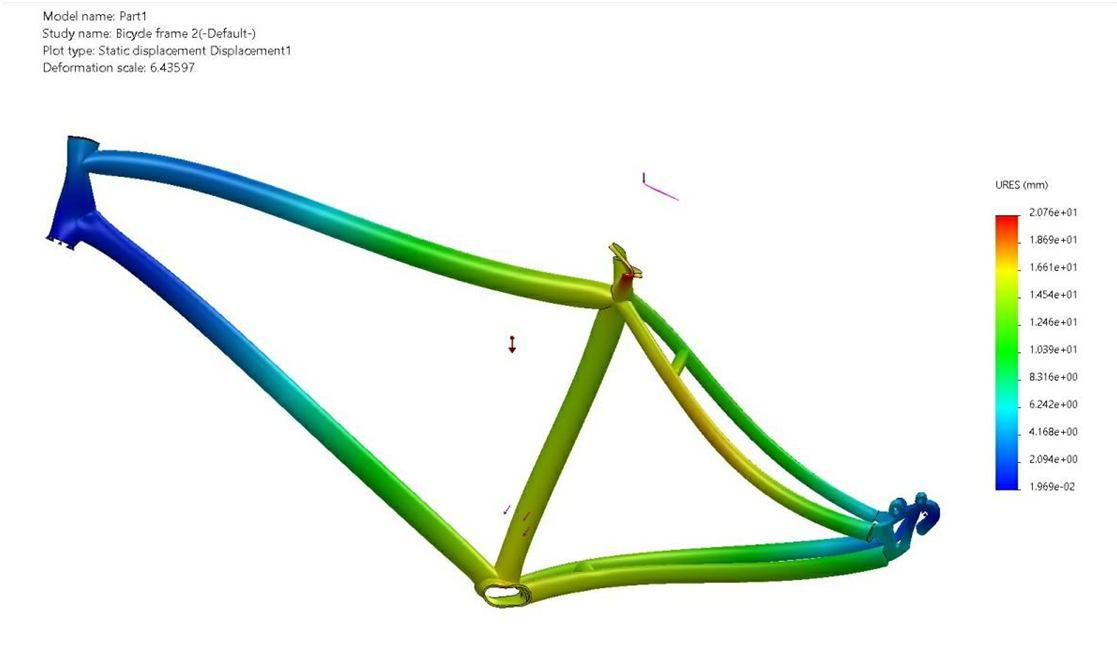
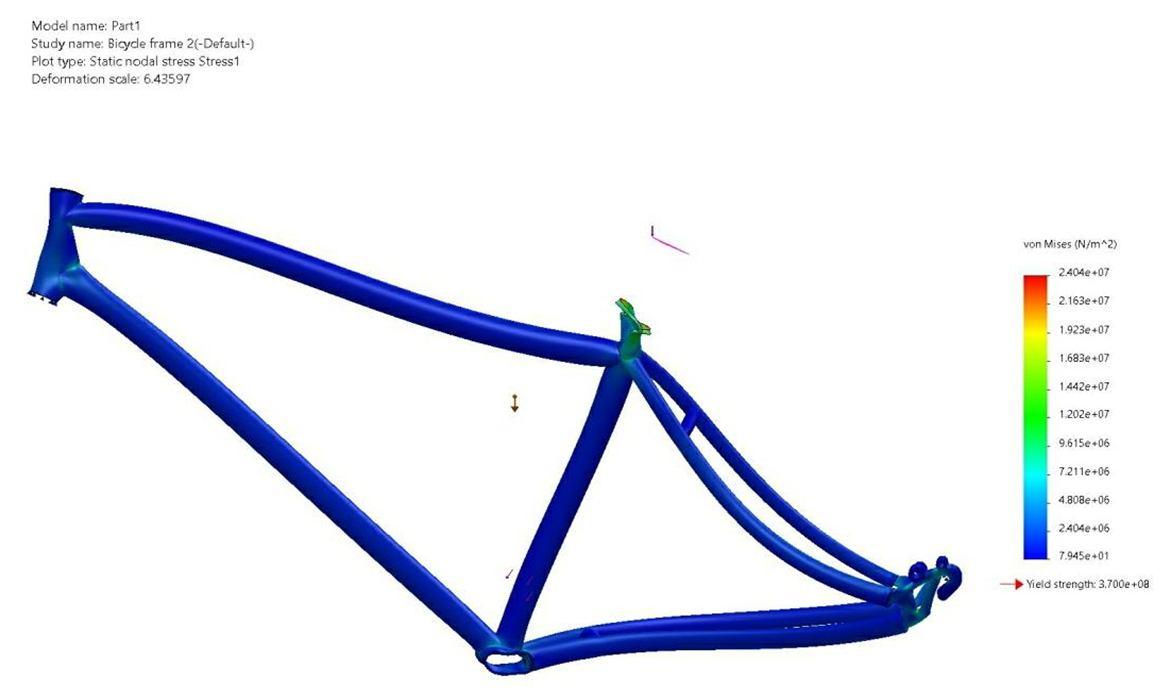


ISSN: 2321 9653; IC Value: 45.98; SJ Impact Factor: 7.538 Volume 10 Issue XI Nov 2022 Available at www.ijraset.com


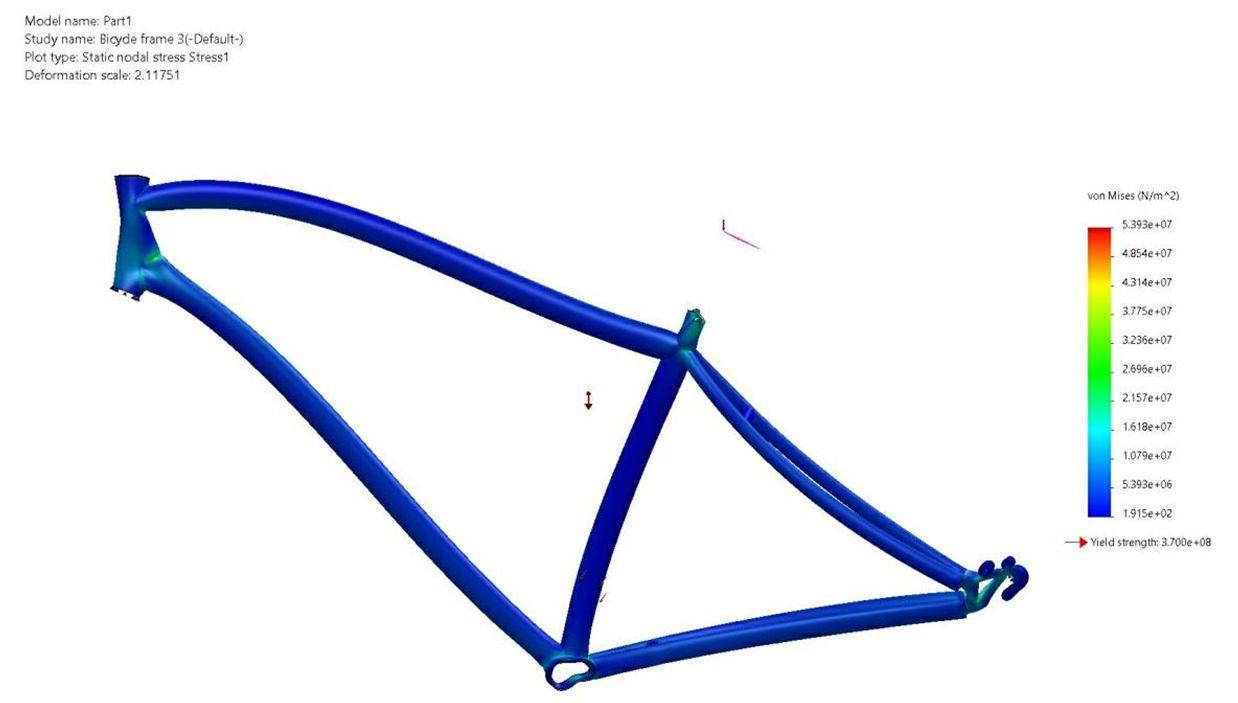


ISSN: 2321 9653; IC Value: 45.98; SJ Impact Factor: 7.538 Volume 10 Issue XI Nov 2022 Available at www.ijraset.com
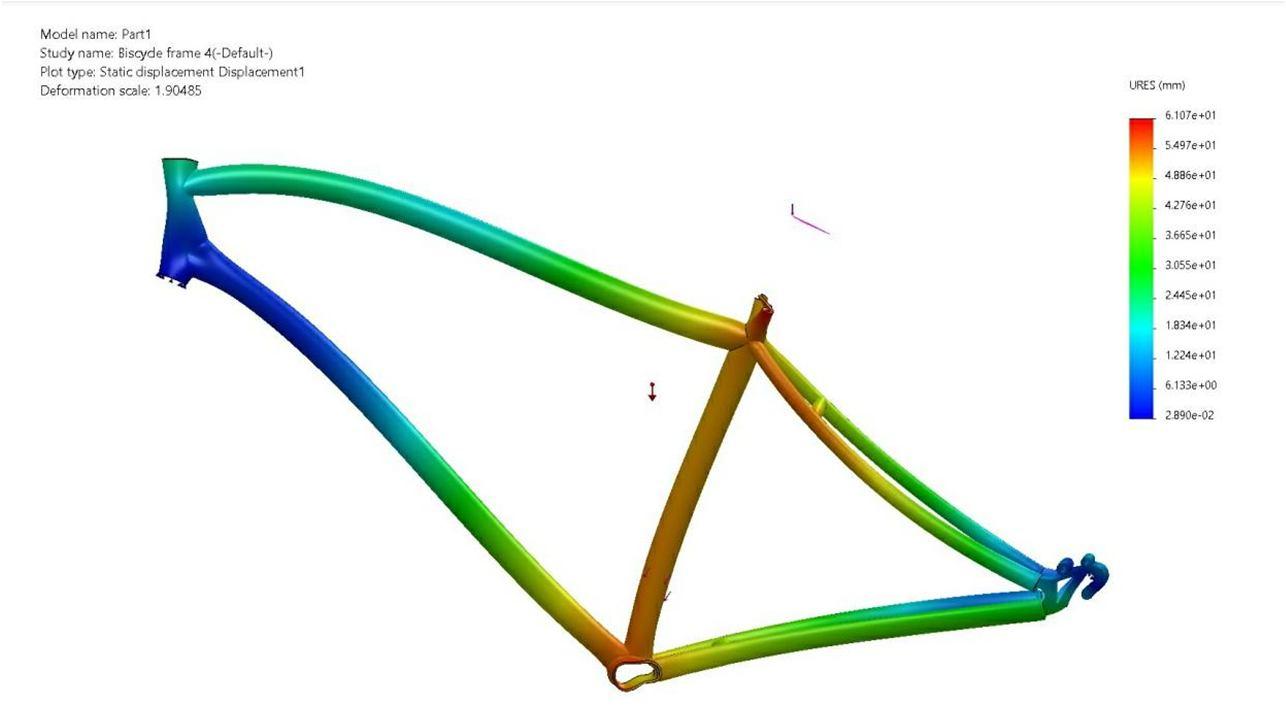




ISSN: 2321 9653; IC Value: 45.98; SJ Impact Factor: 7.538 Volume 10 Issue XI Nov 2022 Available at www.ijraset.com
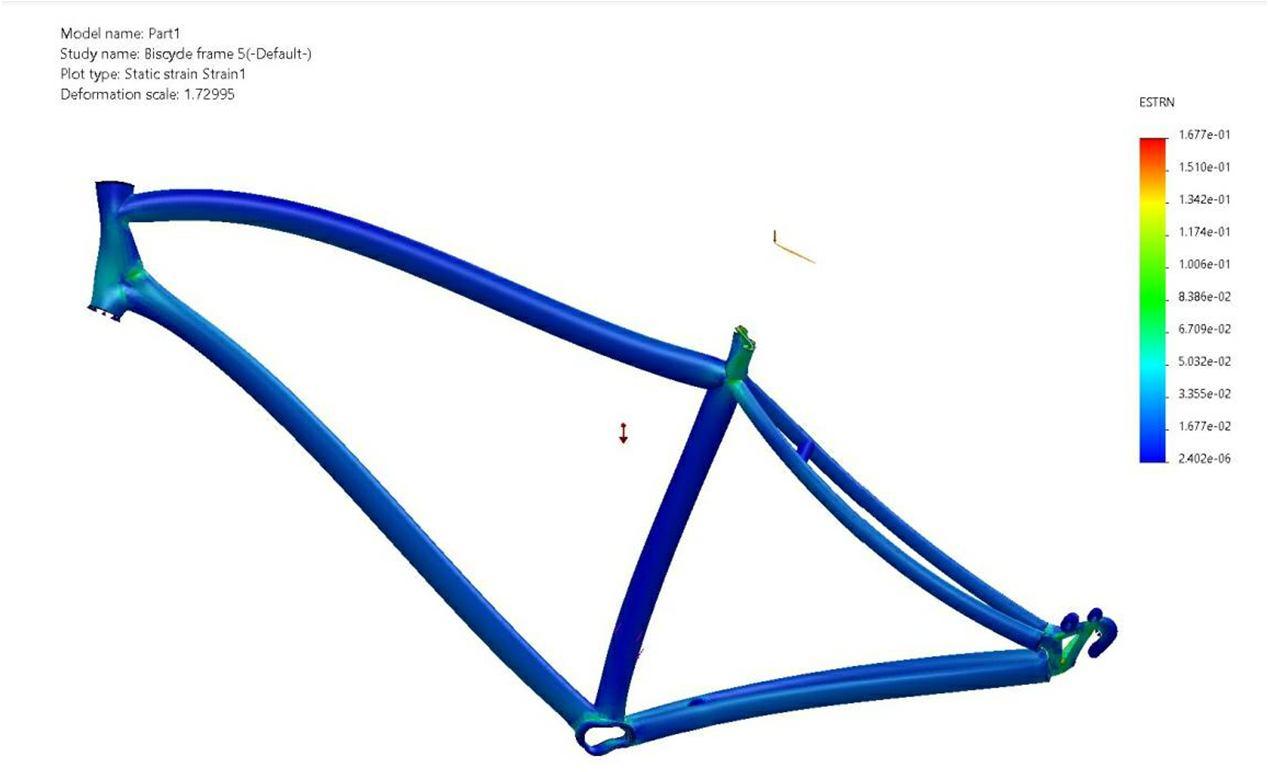
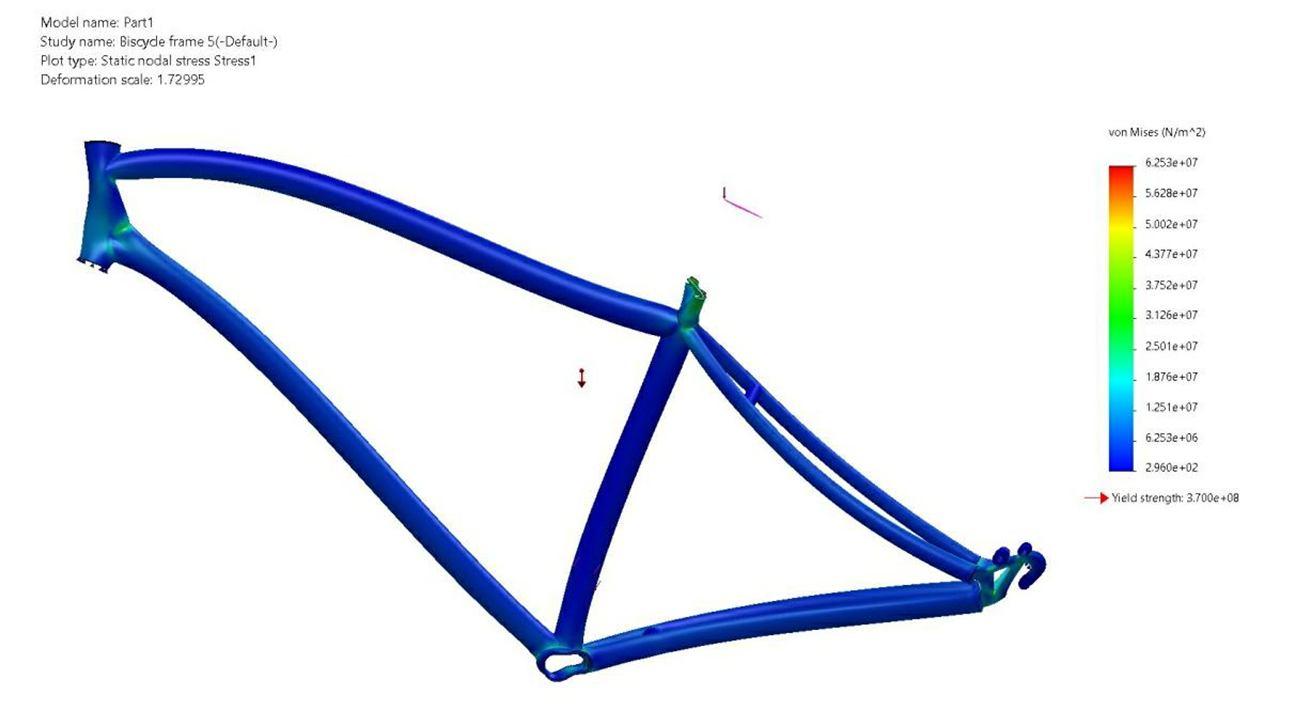



ISSN: 2321 9653; IC Value: 45.98; SJ Impact Factor: 7.538 Volume 10 Issue XI Nov 2022 Available at www.ijraset.com

TABLE. 3.7 AISI 1018 materials low load 1 Force Stress Displacement Strain KgF ᵟ Μ ε

1 10 Min 4.406e3 2.569e 1 2.201e 5 Max 1.099e9 1.3096e4 3.346e+0 2 20 Min 7.945e1 1.969e 2 7.333e 7 Max 2.404e7 2.076e1 5.992e 2 3 30 Min 1.915e2 1.437e 1 1.575e 6 Man 5.393e7 5.274e1 1.526e 1 4 40 Min 2.322e2 2.890e 2 1.742e 6 Max 6.102e7 6.107e1 1.737e 1 5 50 Min 2.960e2 9.624e 2 2.402e 6 Max 6.250e7 6.956e1 1.677e 1
The simulation software is MATLAB / SIMULINK R2020a. The Mat lab / Simulink software is both numeri and symbolic modelling approaches and provides curve fitting, statistics and other core mathematical tools. The Simulink is environment for modelling and simulating, simulation and model based design environment for dynamic and embedded system, integrated with MATLAB. This software is use in components fuel cell (pem), bus sector, scope, voltage measurement, constant, fcn (H2 input), fcn (O2 input), resistor.
Fig.3.1. Design circuit (PEMFC)


Fig.3.2. Stack efficiency

Number of molecular per mole
ISSN: 2321 9653; IC Value: 45.98; SJ Impact Factor: 7.538 Volume 10 Issue XI Nov 2022 Available at www.ijraset.com

W el = q E
N avg = 6.023*1023 molecules /mol
Number of electrons per molecules of H2. n = 2 electron / molecular
Change of 1 electron q el =1.602 * 10 19 coulombs / electron
Change transferred per mode of H2 q = n Navg q el w el = q E w el = nFE where, f = N avg , q el = 96,485 coulomlos / etrectron mole E = ∆G/nF E = 237340 Jmol 1 / 2* 96485 As mol 1 = 1.23 volts
The role of Gibbs free energy w el = ∆G = nFE w el = maximum electrical work ∆G = the change in Gibbs free energy n = the number of electron participation in the rection F = Faraday’s constants E = the ideal potentials of the cell
The standard state Gibbs free energy change of rection in given by ∆G = ∆H T∆S ∆G˚ = CGº + Gº Gº Gº
Fuel Cell Rection H2 = 2H+ + 2e ½ O2 + 2 H+ + 2e = H2O H2 + ½ O2 = H2O
Nernst Equation

E = Eº (RT/2F) In (P H2 / P H2O) + (RT/2F) In (P ½ O2) Cell efficiency η = useful energy / Δ H 1 atmosphere
η ideal = 237.1 / 285.8 = 0.83% (V act ) = (0.83) / E ideal = 1 / 0.675 = 1.17 ~ 1.48 v
1) Polymer electrolyte membrane fuel cell specification 1
Output power = 350 w
Single cell voltage = 0.7 v
Voltage = 12 v Current density = 700 mA cm2
Current (I) = 350 / 12 = 29.2 A Thinkness = 5 mm
No of cell = 12 v / 0.7 v = 17.14 cell ~ 17 cells
Fig.3.3. Bipolar plates

ISSN: 2321 9653; IC Value: 45.98; SJ Impact Factor: 7.538

Volume 10 Issue XI Nov 2022 Available at www.ijraset.com
Stack length (L) = 0.5/cell * 17.14 cells / stack = 8.57 cm2
Areas of A = 29.2/0.7 = 41.71 cm2 ~ 42 cm2
Active area only
Stack power
Power density = ((350) / (8.57 *42)) = 0.97 KW / L
Power density = ((350) / (8.57+ 6) * (72)) = 0.33 KW / L
2) Polymer electrolyte membrane fuel cell specification 2
Output power = 700 W
Single cell voltage = 0.7 V
Voltage = 24 V Current density = 700 mA cm2
Current (I) = 700 / 24 = 29.2 A Thinkness = 5 mm
No of cell = 24 v / 0.7 v = 34.28 cell ~ 34
Stack length (L) = 0.5/cell * 34 cell / stack = 17.2 cm2

Areas of A = 29.2/0.7 = 42 cm2
Active area only
Stack power
Power density = ((700) / (17.2 * 42)) = 0.97 KW / L
Power density = ((700) / (17.2+ 6) * (72)) = 0.41 KW / L
3) Polymer electrolyte membrane fuel cell specification 3
Output power = 1050W
Single cell voltage = 0.7 V
Voltage = 36 V Current density = 700 mA cm2
Current (I) = 1050 / 36 = 29.2 A Thinkness = 5 mm
No of cell = 36 v / 0.7 v = 51.42 cell ~ 52
Stack length (L) = 0.5/cell * 52 cell / stack = 25.7 cm2
Areas of A = 29.2/0.7 = 42 cm2
Active area only
Stack power
Power density = ((1050) / (25.7 * 42)) = 0.97 KW / L
Power density = ((1050) / (25.7+ 6) * (72)) = 0.46 KW / L
4) Polymer electrolyte membrane fuel cell specification 4
Output power = 1400W
Single cell voltage = 0.7 V
Voltage = 48 V Current density = 700 mA cm2
Ampere = 1400 / 48 = 29.2 Think ness = 5 mm
No of cell = 48 v / 0.7 v = 68.57 cell ~ 68.6
Stack length (L) = 0.5/cell * 68.6 cell / stack = 34.7 cm2
Areas of A = 29.2/0.7 = 42 cm2
Active area only
Power density = ((1400) / (34.7 * 42)) = 0.97 KW / L Stack power
Power density = ((1400) / (34.7+ 6) * (72)) = 0.48 KW / L
5) Polymer electrolyte membrane fuel cell specification 5
Output power = 1750W
Voltage = 60 V
Single cell voltage = 0.7 v
Current density = 700 mA cm2
Current (I) = 1750 / 60 = 29.2 A Think ness = 5 mm
No of cell = 60 v / 0.7 v = 85.71 cell ~ 86
Stack length (L) = 0.5/cell * 85.71 cell / stack = 42.85 cm2
Areas of A = 29.2/0.7 = 42 cm2
Active area only
Stack power
ISSN: 2321 9653; IC Value: 45.98; SJ Impact Factor: 7.538 Volume 10 Issue XI Nov 2022 Available at www.ijraset.com

Power density = ((1750) / (42.85 * 42)) = 0.97 KW / L
Power density = ((1750) / (42.85+ 6) * (72)) = 0.50 KW / L
Output power = 2100 W
Single cell voltage = 0.7 v Voltage = 72 V Current density = 700 mA cm2
Current (I) = 2100 / 72 = 29.2 Think ness = 5 mm No of cell = 72 v / 0.7 v = 102.8 cell ~ 103
Stack length (L) = 0.5/cell * 102.8 cell / stack = 51.4 cm2

Areas of A = 29.2/0.7 = 42 cm2
Active area only
Stack power
Power density = ((2100) / (51.4 * 42)) = 0.97 KW / L
Power density = ((2100) / (51.4 + 6) * (72)) = 0.51 KW / L
Table 3.8. stack efficiency calculation
S.NO. Output Voltage Current No of cell Stack length Aera Active area power density
Stack power density W V A Cm2 Cm2 Kw/L Kw/L
1 350 12 29.2 17.14 8.57 42 0.97 0.33
2 700 24 29.2 34.3 17.15 42 0.97 0.42
3 1050 36 29.2 51.43 25.7 42 0.97 0.46 4 1400 48 29.2 58.6 34.7 42 0.97 0.48
5 1750 60 29.2 85.71 42.85 42 0.97 0.50 6 2100 72 29.2 102.8 51.4 42 0.97 0.51
1) The AISI 1018 is using bicycle frame materials. It is analysis in the solid works software
2) It AISI 1018 bicycle frame materials table. 6.1. shown the applying on the load 10kgf on the top of the seat tube it’s stress min max value (4.406e3 1.099e9), Displacement min max value (2.569e 1 1.306e4) , strain min max (2.201e 5 3.346e0)
3) It AISI 1018 bicycle frame materials table. 6.2. shown the applying on the load 20kgf on the top of the seat tube it’s stress min max value (7.945e1 2.404e7), Displacement min max value (1.969e 2 2.076e1) , strain min max (7.333e 6 5.992e 1).
4) It AISI 1018 bicycle frame materials table. 6.3. shown the applying on the load 30kgf on the top of the seat tube it’s stress min max value (1.915e2 5.393e7). Displacement min max value (1.437e 2 5.274e1) , strain min max value (1.575e 6 1.526e 1).
5) It AISI 1018 bicycle frame materials table. 6.4. shown the applying on the load 40kgf on the top of the seat tube it’s stress min max value (2.322e2 6.103e7). Displacement min max value (2.890e 2 6.107e1) , strain min max value (1.742e 6 1.737e 1).
6) It AISI 1018 bicycle frame materials table. 6.5. shown the applying on the load 50kgf on the top of the seat tube it’s stress minimum value (2.960e2 6.250e7), Displacement min max value (9.624e 2 6.956e1) , strain min max value (2.402e 6 1.677e 1).
7) The AISI 1018 bicycle frame materials compare the 10 kgf to 30 kgf load is materiel defect is very less.
8) The AISI 1018 bicycle frame materials compare the 10 kgf to 50 kgf load is materiel defect is very less.
9) It is analysis in material is high capability & high strength & also cost is low for low carbon steel (AISI 1018).
10) The fuel cell is using to parameter is 350W 12V,700W 24V,1050W 36V, 1400W 48V, 1750W 60V , 2100W 72V.
ISSN: 2321 9653; IC Value: 45.98; SJ Impact Factor: 7.538 Volume 10 Issue XI Nov 2022 Available at www.ijraset.com
11) The fuel cell calculation power density value 0.97KW/L. The fuel cell is quick start up property in suitable for automobile application for light duty vehicle.
12) The fuel cell using mat lab software in design circuit.
13) The fuel cell is calculation stack efficiency 30% to 60%.

The fuel cells play the major role in life long usage in fuel sources. In fuel power is solar energy, electrical energy, were conventionally used and it is not found to be much effective. It is about this paper observed the future fuel sources is polymer electrolyte membrane fuel cell (or) proton exchange membrane fuel cell is very useful energy sources. This fuel cell low zero emissions, high efficiency, fuel flexibility, energy security, durability, lifelong usage , transportation properties & maintenance cost is low for compare in other fuel cell. It is always producing in the direct current. It is use to simulation in the mat lab & Simulink software. And also, the low carbon steel good material for the gear bicycle frame. It is use to design & analysis in solid works software. The PEMFCs is analysis in stack efficiency 30 % to 65 % . The fuel cell is calculation find out cell efficiency, stack length, active area power density, stack length power density. The low carbon steel (A36 steel) stress, displacement, strain yield efficiency 3,700e8 find out values. This result is polymer electrolyte membrane fuel cell is best fuel energy sources & the AISI 1018 steel is best gear bicycle frame. The anther components and accessories used in fuel cell systems and electric systems are studied. For future scholar there is a very good opportunity to explore the present area of research.
[1] Le, A. D., & Zhou, B. (2008). A general model of proton exchange membrane fuel cell. Journal of power sources, 182(1), 197 222.
[2] Ul Hassan, N., Tunaboylu, B., & Soydan, A. M. (2019). A competitive design and material consideration for fabrication of polymer electrolyte membrane fuel cell bipolar plates. Designs, 3(1), 13.
[3] Kheirandish, A., Motlagh, F., Shafiabady, N., & Dahari, M. (2016). Dynamic modelling of PEM fuel cell of power electric bicycle system. International Journal of Hydrogen Energy, 41(22), 9585 9594.
[4] Kheirandish, A., Kazemi, M. S., & Dahari, M. (2014). Dynamic performance assessment of the efficiency of fuel cell powered bicycle: An experimental approach. international journal of hydrogen energy, 39(25), 13276 13284.
[5] Kheirandish, A., Motlagh, F., Shafiabady, N., Dahari, M., & Wahab, A. K. A. (2017). Dynamic fuzzy cognitive network approach for modelling and control of PEM fuel cell for power electric bicycle system. Applied energy, 202, 20 31.

[6] Apostolou, D. (2020). Assessing the operation and different refuelling cost scenarios of a fuel cell electric bicycle under low pressure hydrogen storage. International Journal of Hydrogen Energy, 45(43), 23587 23602.
[7] Kuan, Y. D., Ciou, C. W., Shen, M. Y., Wang, C. K., Fitriani, R. Z., & Lee, C. Y. (2021). Bipolar plate design and fabrication using graphite reinforced composite laminate for proton exchange membrane fuel cells. International Journal of Hydrogen Energy, 46(31), 16801 16814.
[8] Shusheng, X., Qiujie, S., Baosheng, G., Encong, Z., & Zhankuan, W. (2020). Research and development of on board hydrogen producing fuel cell vehicles. International Journal of Hydrogen Energy, 45(35), 17844 17857.
[9] Pandian, M. S., Anwari, M., Husodo, B. Y., & Hiendro, A. (2010, October). Efficiency and economics analysis of proton exchange membrane fuel cell. In 2010 Conference Proceedings IPEC (pp. 875 880). IEEE.
[10] Yu, W. L., Wu, S. J., & Shiah, S. W. (2008). Parametric analysis of the proton exchange membrane fuel cell performance using design of experiments. International journal of hydrogen energy, 33(9), 2311 2322.
[11] Ogungbemi, E., Wilberforce, T., Ijaodola, O., Thompson, J., & Olabi, A. G. (2021). Selection of proton exchange membrane fuel cell for transportation. International Journal of Hydrogen Energy, 46(59), 30625 30640.
[12] Sohani, A., Naderi, S., Torabi, F., Sayyaadi, H., Akhlaghi, Y. G., Zhao, X., ... & Said, Z. (2020). Application based multi objective performance optimization of a proton exchange membrane fuel cell. Journal of Cleaner Production, 252, 119567.
[13] Jiao, K., Xuan, J., Du, Q., Bao, Z., Xie, B., Wang, B., ... & Guiver, M. D. (2021). Designing the next generation of proton exchange membrane fuel cells. Nature, 595(7867), 361 369.
[14] Mekhilef, S., Saidur, R., & Safari, A. (2012). Comparative study of different fuel cell technologies Renewable and Sustainable Energy Reviews, 16(1), 981 989.
[15] Sharaf, O. Z., & Orhan, M. F. (2014). An overview of fuel cell technology: Fundamentals and applications. Renewable and sustainable energy reviews, 32, 810 853.
[16] Patil, S., & Kesheorey, G. R. Design & structural analysis on comfort cum riding bicycle frame using FEM. Journal of Mechanical and Mechanics Engineering, 4(1).
[17] Lin, C. C., Huang, S. J., & Liu, C. C. (2017). Structural analysis and optimization of bicycle frame designs. Advances in Mechanical Engineering, 9(12), 1687814017739513.
[18] Ogungbemi, E., Wilberforce, T., Ijaodola, O., Thompson, J., & Olabi, A. G. (2021). Review of operating condition, design parameters and material properties for proton exchange membrane fuel cells. International Journal of Energy Research, 45(2), 1227 1245.
[19] Muthukumar, M., Rengarajan, N., Velliyangiri, B., Omprakas, M. A., Rohit, C. B., & Raja, U. K. (2021). The development of fuel cell electric vehicles A review. Materials Today: Proceedings, 45, 1181 1187.
[20] Mehta, V., & Cooper, J. S. (2003). Review and analysis of PEM fuel cell design and manufacturing. Journal of power sources, 114(1), 32 53.
ISSN: 2321 9653; IC Value: 45.98; SJ Impact Factor: 7.538 Volume 10 Issue XI Nov 2022 Available at www.ijraset.com
[21] M. Badaruddin∗, H. Wardono, Zulhanif, H. Supriadi, M. Salimor “ Experimental investigation of mechanical properties of cold drawn AISI 1018 steel at high temperature steady state conditions” journal of materials research and technology. 2019.

[22] M Badaruddin, R D Kurniawan , Sugiyanto , A Pambudi Low Cycle Fatigue Properties of Aluminizing Coating on ColdDrawn AISI 1018 Steel “International Conference on Engineering Science and Technology” 2019.
[23] E.J. Hernández Ramírez a , A. Guevara Morales b,⇑ , U. Figueroa López b , I. Campos Silva a, Wear resistance of diffusion annealed borided AISI 1018 steel “materials letter” 2020.
[24] Mohammed Z. Hasan a , Ahmed A. Hussein a , Aysha Sh. Hasan a , Obed M. Ali b, Improvement of AISI 1018 Carbon Steel Gr 1018 mechanical properties by liquid carburizing in salt bath, “Materials Today: Proceedings” 2019.
[25] S.Nagendhra , A.S.Rami reddy , Preetham Kumar G Workability Study on Austempered AISI 1018, Materials Science and Engineering 2018.

